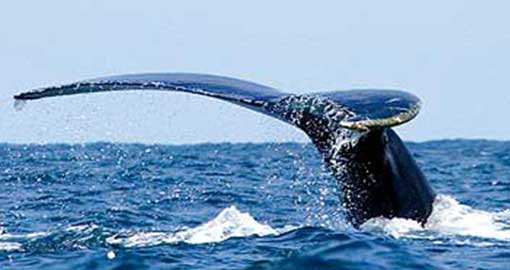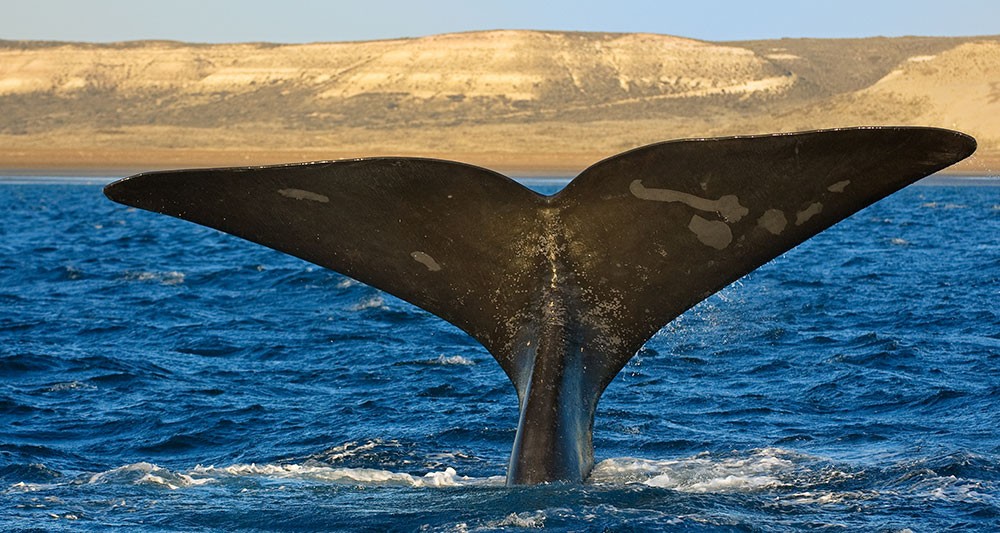
Top 10 Whale Watching Destinations
The largest of all marine mammals (and some of the largest animals in the world), there is no vacation experience that inspires quite as much enchantment and wonder for so many travelers as does whale-watching. Whales are the same species as other marine favorites (dolphins and porpoises), but are split into two distinct subspecies— toothed and baleen, the latter sifting small food particles for food using a filter.
From their soothing songs and unique tail prints akin to human fingerprints, to their massive size (the largest blue whales can reach up to 100 feet and more than 200 tons) and long lifespans (up to 100 years under the best circumstances), whales seem to sing a siren song to humanity. There is just something special about seeing them in their natural habitat, and that habitat is quite large given their migration patterns— the longest migration in the world!
Not surprisingly, there has been dramatic growth in whale watching tourism through the last two decades, creating an economic boon reaching some $2.1 billion for coastal communities around the world, according to the IFAW Global Whale Watching Report. The report estimates more than 13 million people took whale watching tours to 119 countries in 2008 (the last year the report was written). More recent estimates set those numbers even higher, as the international ecotourism industry continues to grow and commercial whaling gains increasing notoriety while on the decline in most parts of the world.
Fortunately for us here at VIP Journeys, some of the best places to see these majestic creatures up close in their natural habitat are in Latin America south of Mexico— areas we know very well! Whether you want to take a full whale-watching vacation or just want to add a private whale-watching tour to your Central or South American journey, we can help (if you go at the right time of year).
Here are our Top 10 destinations for whale-watching in Central America and South America (in no particular order):
Pacific Coast | Colombia
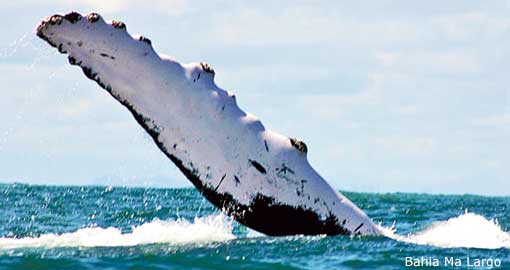 Whale-watching is a popular past time all along the Pacific Coast of Colombia from Nuqui and Bahia Solano to Bahia Malaga, located in Uramba National Park. Although high season is from July to November in this important breeding ground and conservation corridor, Bahia Malaga’s season extends a bit longer due to its more southern location. It also has a higher density of whales than other coastal towns (estimates put the number of whales at between 600 and 1,000 each year). Although remote, these destinations are completely unspoiled and beautiful, boasting a huge amount of biodiversity. Like many of the places on this list, whales migrate north from the colder Chilean waters during this time of year to mate and give birth before heading back south. Bahia Malaga is all about the humpback whale, and it’s not uncommon to see large males breaching the water and jumping in the air.
Whale-watching is a popular past time all along the Pacific Coast of Colombia from Nuqui and Bahia Solano to Bahia Malaga, located in Uramba National Park. Although high season is from July to November in this important breeding ground and conservation corridor, Bahia Malaga’s season extends a bit longer due to its more southern location. It also has a higher density of whales than other coastal towns (estimates put the number of whales at between 600 and 1,000 each year). Although remote, these destinations are completely unspoiled and beautiful, boasting a huge amount of biodiversity. Like many of the places on this list, whales migrate north from the colder Chilean waters during this time of year to mate and give birth before heading back south. Bahia Malaga is all about the humpback whale, and it’s not uncommon to see large males breaching the water and jumping in the air.
Marino Ballena | Costa Rica
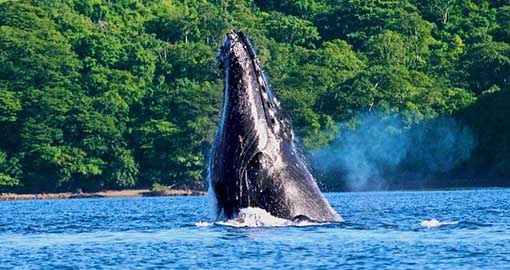 Marino Ballena National Park in Costa Rica, a protected area that extends almost nine miles out to sea, was named for its most famous guest— the humpback whale— and is widely recognized as having one of the longest whale-watching seasons anywhere in the world. This long season is due to the migrations of whales from two parts of the world— Antarctic whales from July through November and North American whales from December to April. Locals and scientists alike say the Antarctic migration boasts the highest number of whales since many North American whales also travel to Hawaii during the winter/spring period. This amazing marine park features an impressive amount of biodiversity and underwater visibility of up to 60 feet— making it the ideal spot to spend the day whale-watching. Adult female humpbacks come to Marino Ballena to give birth and raise their calves. Those who enjoy snorkeling and SCUBA diving also will find this destination to be a virtual treasure trove of other marine life.
Marino Ballena National Park in Costa Rica, a protected area that extends almost nine miles out to sea, was named for its most famous guest— the humpback whale— and is widely recognized as having one of the longest whale-watching seasons anywhere in the world. This long season is due to the migrations of whales from two parts of the world— Antarctic whales from July through November and North American whales from December to April. Locals and scientists alike say the Antarctic migration boasts the highest number of whales since many North American whales also travel to Hawaii during the winter/spring period. This amazing marine park features an impressive amount of biodiversity and underwater visibility of up to 60 feet— making it the ideal spot to spend the day whale-watching. Adult female humpbacks come to Marino Ballena to give birth and raise their calves. Those who enjoy snorkeling and SCUBA diving also will find this destination to be a virtual treasure trove of other marine life.
Puerto Madryn | Argentina
In the small town of Puerto Madryn, on the Valdes Peninsula of Argentina, it is not an uncommon occurrence to walk the beach and witness mother whales and their calves just off shore. The season here runs from June through December, with more whales in the south bay earlier in the season and a larger density farther north a bit later. Whale aficionados will love this locale for its up-close access to both the vulnerable Southern Right whale species and Orcas (with Southern Rights numbering more than 1,000 and fewer Orcas). Argentina takes environmental impact very seriously, so only a few companies are authorized to take whale-watchers aboard boats, but keep a look out for the Orcas famed hunting ability. Many of the whales in this area are catalogued and tracked. Other highlights of the area include the huge sea lion colony at La Loberia (a regular stop on most whale-watching tours) and Playa Doradillio, located just a few minutes south, which offers great whale-watching from the coast. There is a new all-day whale-watching and diving tour available that we adore.
Florianopolis | Brazil
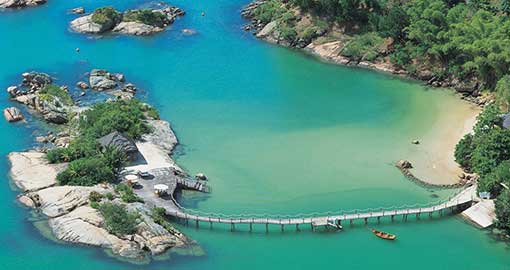 Florianopolis is both a city and an island off the southern coast of Brazil in the state of Santa Catarina, and there is more than one spot in the area known for its spectacular whale-watching. Some of our favorites are Praia do Rosa and Imbituba— both known for their Southern Right whale-watching in season from July through November when Antarctic whales come to the warmer waters to mate and give birth to their calves. Even though the waters are warmer here than the Antarctic, it is important to remember that it is cold in Brazil during this time, so don’t plan on getting in the water and pack accordingly! There is a local whale museum in a converted whaling station called Franca Whale Latin-American that is dedicated to conservation efforts, and scientists do monitor and track whales here. There’s even a Southern Right Whale Environment Protection Area in season. This is in an effort to help replenish their numbers, as the population has dwindled from more than 100,000 to only 7,000 through the years. Whales here come pretty close to shore, and it’s not uncommon to see them from one of our favorite properties— Ponta dos Ganchos.
Florianopolis is both a city and an island off the southern coast of Brazil in the state of Santa Catarina, and there is more than one spot in the area known for its spectacular whale-watching. Some of our favorites are Praia do Rosa and Imbituba— both known for their Southern Right whale-watching in season from July through November when Antarctic whales come to the warmer waters to mate and give birth to their calves. Even though the waters are warmer here than the Antarctic, it is important to remember that it is cold in Brazil during this time, so don’t plan on getting in the water and pack accordingly! There is a local whale museum in a converted whaling station called Franca Whale Latin-American that is dedicated to conservation efforts, and scientists do monitor and track whales here. There’s even a Southern Right Whale Environment Protection Area in season. This is in an effort to help replenish their numbers, as the population has dwindled from more than 100,000 to only 7,000 through the years. Whales here come pretty close to shore, and it’s not uncommon to see them from one of our favorite properties— Ponta dos Ganchos.
Chiloe Island | Chile
 Regularly referred to as a whale-watching paradise, Chiloe Island is a ways south of Santiago off the coast of Chile. Here, is is possible to see whales from land near the Punihuil penguin colony, and there are limited boat tours in season from January through April (some say from December through March). Although tourism is somewhat limited, the numbers of Blue whales, Gray whales and Humpback whales are said to be significant as they make their way south to Patagonia along the forested cliff hills of this national park. The Blue whale is the world’s largest animal, and this area is cited by the scientific community as having the highest number of Blue whale sitings in the whole of the Southern Hemisphere. While visiting this amazing destination, you won’t want to miss the many World Heritage Sites or socializing with some of the friendliest locals anywhere on Earth. This also is a great place to see the critically endangered Darwin’s Fox— an adorable little canine that is one of the smallest in the world.
Regularly referred to as a whale-watching paradise, Chiloe Island is a ways south of Santiago off the coast of Chile. Here, is is possible to see whales from land near the Punihuil penguin colony, and there are limited boat tours in season from January through April (some say from December through March). Although tourism is somewhat limited, the numbers of Blue whales, Gray whales and Humpback whales are said to be significant as they make their way south to Patagonia along the forested cliff hills of this national park. The Blue whale is the world’s largest animal, and this area is cited by the scientific community as having the highest number of Blue whale sitings in the whole of the Southern Hemisphere. While visiting this amazing destination, you won’t want to miss the many World Heritage Sites or socializing with some of the friendliest locals anywhere on Earth. This also is a great place to see the critically endangered Darwin’s Fox— an adorable little canine that is one of the smallest in the world.
Machalilla Park | Ecuador
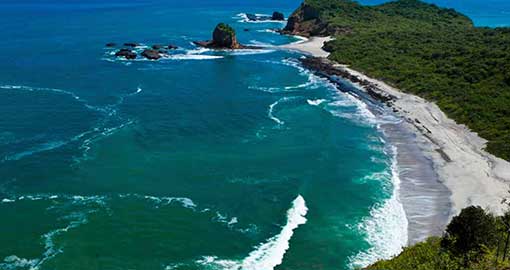 While most people are familiar with the extreme biodiversity of the Galapagos Islands in Ecuador (it even tops most bucket lists), fewer know of the country’s only coastal national park on the mainland— Machalilla Park, created in 1979 as a protection for its rare tropical dry forest. Here, as in Galapagos, the Humboldt Current brings highly nutrient rich waters that are perfect feeding grounds for whales (and other marine animals). There are 28 species of whale and dolphin in these waters during season from June to October, and estimates ranging from 400 to several thousand humpbacks come here to breed. Most whale-watching tours depart from Puerto Lopez, which is just a bit south of the national park, and head past Isla del la Plata in the park, where it’s possible to see large numbers of whales swimming to and from the island. Be sure to check out the important archeological sites in the area too!
While most people are familiar with the extreme biodiversity of the Galapagos Islands in Ecuador (it even tops most bucket lists), fewer know of the country’s only coastal national park on the mainland— Machalilla Park, created in 1979 as a protection for its rare tropical dry forest. Here, as in Galapagos, the Humboldt Current brings highly nutrient rich waters that are perfect feeding grounds for whales (and other marine animals). There are 28 species of whale and dolphin in these waters during season from June to October, and estimates ranging from 400 to several thousand humpbacks come here to breed. Most whale-watching tours depart from Puerto Lopez, which is just a bit south of the national park, and head past Isla del la Plata in the park, where it’s possible to see large numbers of whales swimming to and from the island. Be sure to check out the important archeological sites in the area too!
Galapagos Islands | Ecuador
No whale-watching list is complete without the wondrous Galapagos Islands (also in Ecuador and similar in many ways to Machalilla Park). Here, in these nutrient-rich waters where some whale species live year-round, it is possible to go whale-watching at any time of the year. However, July through November is considered the best time to spot a large variety of the marine giants due to the particularly dense nutrients brought in by the Humboldt Current. The best places to see whales, including Humpbacks, Orcas, Blue, Fin, Bryde’s, Pilot and Sperm (in pods of 20+), is around Isabela, Fernandina, Wolf and Darwin. Whale sharks also can be viewed in the Galapagos, and this naturally curious species, along with the naturally-curious Orcas and dolphins, will often approach boats to investigate and give whale-watchers unexpected up-close encounters. Of course, you won’t want to miss the rest of the destination that top’s more people’s bucket lists than any other in the world, so click through to our Galapagos post to learn more about the destination.
Mancora | Peru
In the small fishing village of Mancora in northern Peru, the Humpback whale season runs from August through October, when it’s even possible to see them breaching the water just off shore— though this amazing sight still is best seen by boat. Mancora is very much a hidden gem known by experienced travelers as much for its remoteness as for its thriving eco-tourism industry and accessibility to a bevy of adventure sports, including SCUBA diving and kitesurfing. Whale-watching season also happens to be during the same time surfers from around the globe descend on this small town for its warm, sunny days and great breaks. It should come as no surprise, then, that this charming village also knows how to host some pretty raging all night parties and cook up some very tasty cuisine. Since Mancora is relatively close to the Galapagos Islands, you should expect to see sea lions, dolphins and blue footed boobies alongside the whales here. Locals take the very long bus ride to get here, but we recommend flying from Lima and chartering a car service or entering from the Ecuador side.
Gulf of Chiriqui | Panama
 Often referred to as “the lost coast,” the Gulf of Chiriqui National Marine Park in Panama is renowned as some of the very best whale watching in the world. It is a protected archipelago with more than 25 islands and islets, as well as warm shallow waters that are just perfect for whales to mate and give birth to their calves. Although it is possible to see whales from shore (we love Cala Mia Boutique Island Resort at Boca Chica for its views), experts recommend heading out into the Gulf near groups of islands and outcroppings for the best views of this important nesting ground. The whale-watching season in the Gulf of Chiriqui runs from July through late October, with the latter months being more active due to the Humpback migration from the Antarctic. One of our favorite times to visit in the past has been during the annual whale festival that takes place each August.
Often referred to as “the lost coast,” the Gulf of Chiriqui National Marine Park in Panama is renowned as some of the very best whale watching in the world. It is a protected archipelago with more than 25 islands and islets, as well as warm shallow waters that are just perfect for whales to mate and give birth to their calves. Although it is possible to see whales from shore (we love Cala Mia Boutique Island Resort at Boca Chica for its views), experts recommend heading out into the Gulf near groups of islands and outcroppings for the best views of this important nesting ground. The whale-watching season in the Gulf of Chiriqui runs from July through late October, with the latter months being more active due to the Humpback migration from the Antarctic. One of our favorite times to visit in the past has been during the annual whale festival that takes place each August.
Placencia | Belize
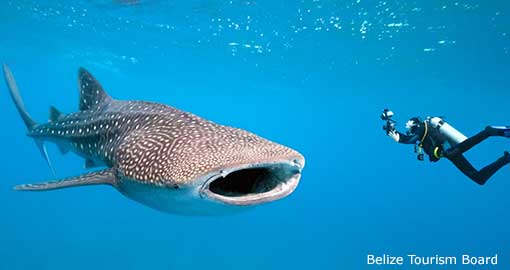 Though not actually whales, the largest fish in the world can reach more than 40 feet, which probably contributes to whale sharks often being mistaken for their mammoth cousins and helps to explain why people are so mesmerized by them. We think this deserves an honorable mention! Placencia, Belize is one of the best places in the world to see these night-feeding gentle giants— especially at the Gladden Spit during the periods just before, during and just after the full moon in April, May and September. Gladden Spit is a marine reserve created to help ensure responsible tourism, so there are regulations in place to minimize human impact on whale sharks and other marine life. Boat captain whale shark certifications are required, only a certain number of boats are allowed on the water at any given time, there are time limits to how long boats can be in the conservation zone, no boats are allowed in the zone after 5pm, and no flash photos are allowed at all. It’s worth navigating the regulations though, as whale sharks are very curious and will most likely approach boats or swimmers in the water. They aren’t called gentle giants for nothing though, so don’t be scared!
Though not actually whales, the largest fish in the world can reach more than 40 feet, which probably contributes to whale sharks often being mistaken for their mammoth cousins and helps to explain why people are so mesmerized by them. We think this deserves an honorable mention! Placencia, Belize is one of the best places in the world to see these night-feeding gentle giants— especially at the Gladden Spit during the periods just before, during and just after the full moon in April, May and September. Gladden Spit is a marine reserve created to help ensure responsible tourism, so there are regulations in place to minimize human impact on whale sharks and other marine life. Boat captain whale shark certifications are required, only a certain number of boats are allowed on the water at any given time, there are time limits to how long boats can be in the conservation zone, no boats are allowed in the zone after 5pm, and no flash photos are allowed at all. It’s worth navigating the regulations though, as whale sharks are very curious and will most likely approach boats or swimmers in the water. They aren’t called gentle giants for nothing though, so don’t be scared!
If you’re ready to grab your binoculars and get up close and personal with these majestic creatures, contact us today to begin planning your whale-watching tour. Then, read on to learn more about whale-watching etiquette, according to the Pacific Whale Watch Association:
- Stay 200 yards away, and keep paths clear (bring binoculars)
- Approach with extreme caution from the side and run parallel rather than from front or back
- Stay on the offshore side so you don’t upset courtship, cause injury or separate mothers and calves
- Remember, a vessel within 1/2 mile of a whale is considered “in the vicinity” of whales
- Operate boats in low wake speed
- Turn off fish finders, depth sounders, sonar and other underwater transducers when possible
- Don’t touch!
- Don’t chase!
When in doubt, keep in mind “whales need space to find food, choose mates, raise young, socialize and rest…so don’t get too close, approach too fast or make too much noise” that could cause stress. Then, get out there and have fun!




